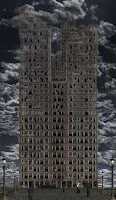



French artist, born 1952.
Fascinated by photography from an early age, Jean-François Rauzier graduated from the School Louis Lumière in 1976. He has since been working as a professional photographer, while developing a personal creative work.
In 2002, his artistic work takes an innovative and radical turn: he invents the concept of the HYPERPHOTO. He creates virtual images consisting of several hundreds of shots, taken with a telephoto lens and assembled by computer.
In his monumental works he mixes the infinitely big and the infinitesimal, in a profusion of details so unusual as fascinating. The image thus recomposed numerically gives way to the dreamlike world of the artist.
For a few years, this virtuoso of the digital technologies has been receiving the recognition and praise of his peers. He is the winner of prestigious artistic and photographic awards: in 2006, the show Up-date in Berlin awarded him the Screenings prize, in 2008, he received the Arcimboldo award for the digital creation, in 2009 he was rewarded by the APPPF in the category photograph of architecture and in 2010 he received the Eurazeo prize.
His works immerse the spectator into a dreamlike, sometimes fantastic universe. They offer a reflection on reality, the place of man in the city, the perception of the world and an invitation to a an exceptional journey.
he is exhibited throughout the world : New York, Londres, Los Angeles, Paris ou Séoul…
Jean-François Rauzier was immediately captivated by numerical photography when it penetrated the professional market 15 years ago. He has been exploring the multiple opportunities offered by computer’s retouching since then, turning himself into a “virtual” painter.
In 2002, he created the “Hyperphoto”, a concept which enables him to deal with the impossible: to combine both infinitely big and infinitely small things in one same image, out of time.
To simulate the illusion of reality, Jean-François Rauzier first had to cope with all the inherent limits inherent of the photographic and technological equipment.
He found his way by juxtaposing, duplicating, twisting images with Photoshop, making it possible for him to reproduce human vision more accurately. This way, he generated a genuine numerical puzzle, in which the pieces, cut out, “drawn again”, come up along on top of the imagination of the artist.
From this technique is issued numerous fascinating and unusual details on which the spectator can dwell on.
The multitude of images invite the spectators to an inside journey, in dream-like, fantastic and timeless worlds. These worlds are filled with icons and references born of the artist’s cultural hall of fame.
My photography of the insides of Barcelona














No comments:
Post a Comment